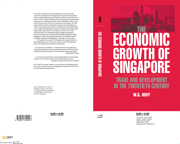Book contents
- Frontmatter
- Contents
- List of figures
- List of tables
- Preface and acknowledgements
- Abbreviations and conventions
- Geographical definitions
- Introduction
- Part One Themes and beginnings
- Part Two Development as a staple port, 1900–1939
- 3 Trade, finance and development
- 4 Ocean-going shipping, the port and regional transport
- 5 Immigration, population and employment
- 6 Rubber: boom and spread of a twentieth-century staple
- 7 Rubber, industrialization and the development of Chinese banking
- 8 Petroleum and tin: the twentieth-century boom commodity and a staple in decline
- 9 The distribution of manufactured imports
- Part Three Staple port and rapid growth, 1947–1990
- 12 Conclusion
- Appendix tables
- Bibliography
- Index
6 - Rubber: boom and spread of a twentieth-century staple
Published online by Cambridge University Press: 22 September 2009
- Frontmatter
- Contents
- List of figures
- List of tables
- Preface and acknowledgements
- Abbreviations and conventions
- Geographical definitions
- Introduction
- Part One Themes and beginnings
- Part Two Development as a staple port, 1900–1939
- 3 Trade, finance and development
- 4 Ocean-going shipping, the port and regional transport
- 5 Immigration, population and employment
- 6 Rubber: boom and spread of a twentieth-century staple
- 7 Rubber, industrialization and the development of Chinese banking
- 8 Petroleum and tin: the twentieth-century boom commodity and a staple in decline
- 9 The distribution of manufactured imports
- Part Three Staple port and rapid growth, 1947–1990
- 12 Conclusion
- Appendix tables
- Bibliography
- Index
Summary
It has been shown that the growth of Singapore's traditional primary exports to the West represented a response by regional producers to Western demand; that entrepreneurial and service functions performed in Singapore facilitated this response; that these functions were an important part of Singapore's development; and that they created opportunities for further development. What set rubber apart from the traditional primary exports to the West was the extent of these effects on Singapore. In rubber exports, Singapore found an engine of growth which operated more powerfully than its predecessors and made possible the emergence of a much more diversified and developed economy.
There were four reasons for the sweeping impact that rubber had on Singapore. First, as observed in chapter 3, it increased the value of Singapore's exports considerably more than any other commodity. Second, the bulkiness of rubber led to an expansion of transport, handling and port facilities, discussed in chapter 4. Third, for most of the period the rubber industry, in providing the main stimulus to immigration to British Malaya, also promoted Singapore's own rapid population growth, considered in chapter 5.
The fourth reason, taken up in this chapter, was that the economics of rubber production left entry to the industry open to all types of producers, because the same commodity could be produced competitively with very different factor combinations, and because most of the processing could wait until the coagulated latex reached a central mill.
- Type
- Chapter
- Information
- The Economic Growth of SingaporeTrade and Development in the Twentieth Century, pp. 180 - 207Publisher: Cambridge University PressPrint publication year: 1994



